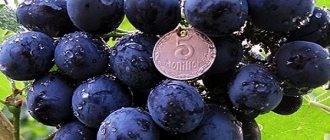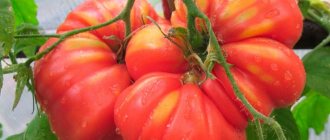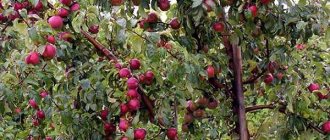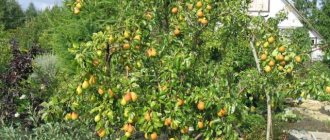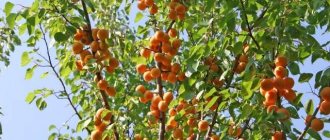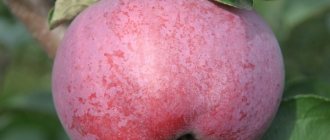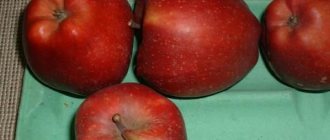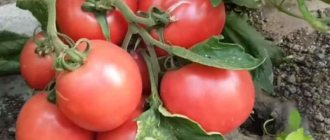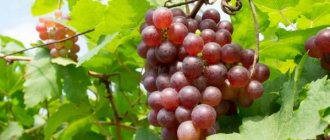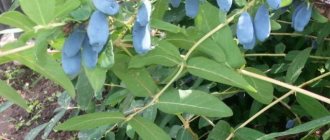» Gardening » Apple tree » Growing the Zavetnoe apple tree
0
2033
Article rating
The Zavetnoye apple tree was bred in 1958 at the Siberian Scientific Research Institute of Horticulture named after M. A. Lisavenko. The hybrid was obtained by crossing the varieties Autumn Joy and Melba. The main goal of the breeders was to create a sustainable species with tasty fruits.
- Landing
- Selecting a location
- Planting scheme
- Care
- Watering
- Fertilizers
- Trimming
- Disease and pest control
- Features of ripening and fruiting
- Harvest and storage
- Subspecies and options
- Features of cultivation in different regions
- Reviews from gardeners
Growing the Zavetnoe apple tree
Apple tree Zavetnoe
Zavetnoye is a semi-cultivated variety . Zoned throughout Siberia, Tomsk, Omsk regions, and the Urals. Can grow successfully in Tyumen. Belongs to early winter varieties. Ripening occurs by the end of September. The apples will ripen very well . The bush becomes very beautiful when it has a large number of red apples.
It is inferior to cultivated varieties, perhaps, only in the size of the fruit. It has the following appearance: a low tree with a very wide crown in diameter.
The branches are located almost perpendicular to the main trunk. The tree of this variety is distinguished by the dark brown color of the trunk bark.
Side shoots almost always grow straight, densely covered with foliage.
The leaf is pointed, dark green with a jagged edge, slightly wavy.
Important! Another distinctive feature of the tree is the absence of odor during flowering. It is certainly there, but almost elusive.
additional characteristics
This variety of apple tree is distinguished by certain characteristics. Let's take a closer look at the main characteristics.
Advantages and disadvantages
The main advantages of the variety are:
- Frost resistance;
- Fruiting begins in the fourth year after planting;
- The tree is resistant to scab and pests;
- The annual yield is up to 70 kg per tree, which is a high figure;
- High productivity is achieved both in a young tree and in an adult;
- Friendly maturation;
- Long shelf life (5 months);
- Good transportability.
The main disadvantage of the Zavetnoye apple tree is its poor resistance to very low temperatures in winter. In severe winters with little snow, even old trees can freeze.
Tree height
The Treasured tree is low-growing, reaching a height of 2-2.5 meters . Sometimes it grows up to 3.5 meters.
Crown width
The crown of the tree is very spreading, slightly thickened , which is an excellent factor for the tree. Throughout the summer, the sun's rays evenly penetrate through the sparse crown, which is why the fruits ripen together and are ventilated with air. This saves the tree from scab.
Apple tree Zavetnoye at the age of 15 years.
Productivity
As noted above, the yield is stable from year to year. Despite the age of the tree, you can collect up to 70 kg of bright red apples. The harvest begins in the second half of September.
Attention! A distinctive feature is the length of storage of the crop until mid-winter.
Average fetal weight
The fruits weigh up to 80 g , and 40-60 g in subsequent years. This is due to the fact that every year more apples are formed on the tree, which is why they become smaller. But despite this, the taste does not deteriorate.
In addition, they have a wonderful appearance. A small apple is white, half of the fruit is occupied by a red blush.
Tasting assessment
Apples have dense pulp , which when broken, produces a special audible crunch. Despite the excessive density, the flesh is tender and juicy.
Many gardeners note that apples have a strawberry flavor. They are especially sweet when cold weather occurs in September, which prevents them from fully ripening. If the weather is hot in summer, then ripening begins at the end of August.
Fruits of the Zavetnoe apple tree.
The fruit is round, without flattening. It has a valuable biochemical composition. Among the chemical components are vitamins E, B2, B1, B6, as well as various beneficial amino acids that can improve human immunity and replenish vitamin deficiencies during the winter.
Winter hardiness
Perennial bark is severely damaged by low temperatures. At a temperature of -40, a perennial tree may freeze.
Disease resistance
Resistance to scab and other diseases is very high ; it is enough to spray with a fungicide solution in the period before flowering and there will be no disease.
To completely protect your treasured plant from scab, treat it with a fungicide before flowering.
Watch the video review of the Zavetnoe apple tree:
Reviews
By going to forums on the Internet, you will learn a lot of new things for yourself. Summer residents share their experience in growing fruit crops, ask questions that interest many in various areas of gardening, and some answer them. Such communication helps to increase personal skills in planting and caring for apple trees, among other things.
Tatyana is 34 years old, from Ust-Kalmanka, Altai Territory. “Despite my young age, I have several apple trees on my plot. The varieties were chosen taking into account the harsh climatic conditions. In winter we have frosts down to -42 degrees. There is little snow; what is available in the garden is blown away by strong winds. However, there is no security. I purchased the seedlings exclusively from the gardening nursery named after. Lisavenko, in the city of Barnaul. I have apple trees of the Gardener’s Gift, Surkhurai, Zavetnoe and Yunga varieties. I would like to note about the Zavetnoe variety. The tree is small, compact, and can even be called a bush. Last year began its fruiting for the first time.
I collected few fruits. But the apples were so delicious—it’s simply impossible to describe the children’s delight. The collection was held in September, which I really liked. First we ate the fruits of Yoongi, then the Cherished apples arrived. Juicy, with white-green flesh, sweet and sour apples were liked by everyone in the household.”
Valentina, 65 years old, Barnaul. “I live in the city, I have a dacha. At first the plot was small, then I bought neighboring land. I want to plant everything to please my grandchildren. The Zavetnoe apple tree has been growing for me for 13 years. I am constantly worried that the yield will begin to decline. But neighbors in the country say that the age of a tree of this variety does not affect the quality and quantity of the harvest. The apple tree does not cause any trouble. The only thing is that during heavy snowfalls the lower branches break off, but that’s okay; in the spring I simply saw them off with a hacksaw. And rabbits can also spoil my favorite bush a little. To combat them, I wrap the tree with plastic burlap and plastic bottles on top.
I treat my trees with love and care, and they delight me with large harvests of beautiful and tasty apples. I would like to give advice, the variety adapts well to the harsh winters of Western Siberia, so when choosing an apple tree seedling for yourself, pay special attention.”
Again, in the vast gardening forum there is one interesting parable , which was shared by one author, without leaving his name , back in 2011. “If an apple tree did not bear a harvest, then in the old days they buried an iron ax under the bush, saying: “If you don’t give a harvest, we will cut it down.” This is, of course, a fairy tale, but according to scientific explanations it can be stated as reality. Burying iron in the roots of a tree creates a magnetic field that disrupts sap flow. At this time, the laying of fruit buds occurs, which means the apple tree will begin to bear fruit. Here is an interesting fact that can be put into practice. I heard that this method is used when planting plum trees, but instead of an axe, they bury unnecessary scrap metal.
But the Zavetnoye apple tree does not need additional stimulants, since it already bears fruit remarkably well, and without rest.”
How to plant?
Planting the Zavetnoe apple tree does not require any special agricultural techniques. It is only recommended to take into account the climatic conditions of the region, especially in winter.
Important! It is necessary to carefully consider the choice of young seedlings so as not to confuse them with Kazakh hybrids that cannot tolerate low temperatures. Minimum values for this variety: -30 degrees.
Landing dates
It is recommended to plant seedlings of this apple tree in mid-March, and in colder areas even in April. The temperature regime must be stable. Sudden frosts will destroy young trees. The soil should already warm up to at least +10 degrees.
Features of planting and care
The Zavetnoye apple tree variety does not have its own planting and care characteristics. All methods of agricultural technology for fruit trees are acceptable for her. When choosing a variety, you need to take into account all the climate conditions in which the apple tree will grow.
Advice! Buy seedlings only from trusted sellers. When choosing, the main thing is not to run into Kazakhstani young trees that cannot tolerate low temperatures, even -30 degrees.
Landing
Deadlines
The tree should be planted mainly in the spring , when severe frosts have already passed. To do this, in the fall the seedling can be buried at an angle of 45 degrees to the ground. This is done for storage. And in the spring, when the snow melts and the top layer of the earth thaws, you need to plant it in a permanent place. In Siberia, you need to adhere to the April planting dates.
For the winter, bury the seedlings at an angle of 45 degrees.
Selecting a location
The location for the future tree should be chosen to be illuminated . Try to choose a site so that it is protected from winds and snow accumulates on it. If the soil is infertile, then fertilizer must be added when planting. especially responsive to humus.
Technology
This procedure is simple even for beginners:
- For a seedling, dig a hole measuring 60*60 cm in different directions and up to 0.5 meters deep;
- Mineral and organic fertilizers should be added to the bottom of the hole;
- Then we make a small hillock at the bottom, onto which we lower the young plant. You should straighten the roots, then dig in with earth. The seedling needs to be deepened to the scion site;
- Compact the soil and cover it with mulch. You can use cut straws as mulch. Many people do this with sawdust, but this is wrong, as they delay the evaporation of excess moisture, and this is detrimental to a young tree;
- Water the newly planted bush abundantly.
Advice! A stake should be stuck near the seedling to prevent it from being blown around by the wind.
There is no need to plant in the fall, as the tree does not have time to take root in the harsh conditions of Siberia. You just need to dig in the seedling to save it until spring.
Watch the video on how to plant an apple tree in spring:
Agricultural technology
Fruit tree care includes:
- Watering;
- Feeding;
- Bush formation;
- Pest and disease control.
Let's start with watering. This is an integral part of agricultural technology. At first, the seedling is watered as the earthen coma dries up , then as the tree matures, watering is carried out twice a season, that is, before flowering and after shedding its leaves. You can water several times during the summer if the weather is very hot.
The apple tree must be watered twice a season.
To feed apple trees, mullein and mineral fertilizers , mainly urea, are used. They are introduced in the spring into the tree trunk circle, then digging up the top layer of soil without affecting the root system.
Apple trees are very responsive to fertilization with mullein.
The most important maintenance procedure is pruning the bush and forming the crown. This should be done in early spring , before the sap begins to move along the trunk and branches. Shaping and pruning are necessary to ensure the passage of air and light into the crown so that the bush does not become thickened. According to the advice of experienced gardeners, incorrect shoots are cut off; horizontal shoots cannot be touched, as they are the key to the future harvest.
General diagram of the formation of the crown of an apple tree.
Watch a video tutorial on pruning and crown formation below:
Even if the Zavetnoye variety is resistant to scab and many pests, for prevention in early spring the tree is sprayed with a solution of urea, copper sulfate and water.
For more information on how to deal with scab, watch the following video:
Special barrier belts against codling moths . To prevent the appearance of rodents in winter, all fallen leaves are raked around the tree, burned , the tree trunk is dug up and the tree trunk is wrapped in protective materials.
Protecting the apple tree from rodents.
Advice! Spruce paws, which are laid out around the neck of the root, are suitable for repelling mice.
Pollination
The best varieties that contribute to fruitful cross-pollination of Zavetny are:
- Firebird;
- Altai Rumyanoye;
- Altai Bagryanoye.
Firebird.
Altai Rumyanoye.
Altai Bagryanoye.
Instead of an afterword - briefly about the most important
- Zavetnoye is a variety for northern conditions. This apple tree has proven itself well in Altai, Tyumen and Omsk regions.
- The seedling will take root well in a sunny area. Groundwater should not approach the root system, so choose the upper reaches rather than the lowlands. Zavetnoye prefers soil that is fertile and of medium structure - black soil, loam or sandstone.
- The tree is not fussy to care for. It needs several waterings per season, spring (or spring + autumn) fertilizing, spring pruning, and protection of the trunk from rodents. That is, in fact, you will only deal with wood in early spring and late autumn. Although in the summer you also need to look to see if pests have infested or if a disease has started - the whole thing will have to be eradicated with a special means.
Are there other successful semi-cultures for the northern regions? Of course yes! You will learn about them from this video:
Features of ripening and fruiting
As noted above, the variety begins to produce its first harvests in the fourth year after planting the seedling. The main feature of this variety is its annual regular fruiting.
During a season, it is possible to collect up to 70 kg of apples from a mature tree, and the smooth ripening of fruits brings only convenience to summer residents.
As you know, the ripening period begins at the end of September .
Since the harvests from Zavetny are plentiful , this is the first candidate for winter harvesting. Compotes, juices, preserves, and jams are prepared from the harvest. You can make dried fruit or just freeze it.
Productivity
After grafting, an apple tree of this variety begins to bear fruit already in the fourth year. Even old trees can bear fruit.
After this, the frequency of fruiting is regular, annual . The yield is quite abundant - about seventy kilograms per unit of tree.
Since the apples on the tree ripen at the same time, harvesting is convenient. The fruits are also intended for transportation.
Apples can be processed, canned, eaten fresh or in cooking.
Subspecies and options
The main subspecies or those with similar characteristics are the apple trees through which the crossing occurred. This is Melba and Autumn Joy. The fruits of these varieties are similar in appearance to Zavetny and have the same growing conditions.
Melba.
Autumn Joy.
Peculiarities of ripening in different regions
Despite the fact that the Zavetnoye variety has low resistance to severe frosts, this variety is widespread . If winter temperatures are very low, this is not a reason to panic.
The entire tree may not die, but only some of its branches and a little bark. Therefore, warm winter weather, weak winds, and moderate amounts of snow are considered the best.
Depending on climatic conditions, ripening can occur from late August to late September.
That is, if you plant a tree from Moscow to the Urals, then fruiting will be early, in the Siberian region - in September, and so on. Changes will occur as the temperature regime changes across the country.
History of creation
The Zavetnoye apple tree was bred at the NIISS named after. Lisavenko in Siberia in 1958. As a result, it has been fruitfully grown for 60 years, without losing its position. The variety was obtained by crossing two species: Autumn Joy and Melba. The half-cultivated Zavetnoye apple tree took only the best characteristics from its ancestors. First of all, we are talking about an excellent indicator of cold resistance, as well as resistance to pests and diseases.
Currently, the crop is grown throughout almost the entire Western Siberia. Gardeners like the Zavetnoe apple tree for its abundant fruiting and late fruit ripening.
Apple tree Zavetnoe
FAQ
Why doesn't the apple tree grow?
The reason may be a strong deepening of the root trunk . Why does the bark rot when watering? This, in turn, prevents the tree from developing. As a result, the tree will die. If you scrape the earth away from the trunk, you can see the reason. can also interfere with growth.
When planting, make sure that the root collar is not buried.
Why do rusty spots form on leaves?
This is scab , you need to spray it with fungicide.
Is it possible to replant a 10-year-old tree?
It’s possible, but the tree will hurt badly and for a long time . Of course, this is very problematic, since the formed tree has a large size and root system. To replant, you need to dig a huge hole, this needs to be done in advance. Pour a lot of humus into it so that the roots begin to feed immediately after transplanting. And keep plenty of watering for the first time. It should take root.
Transplanting an adult apple tree is quite problematic.
